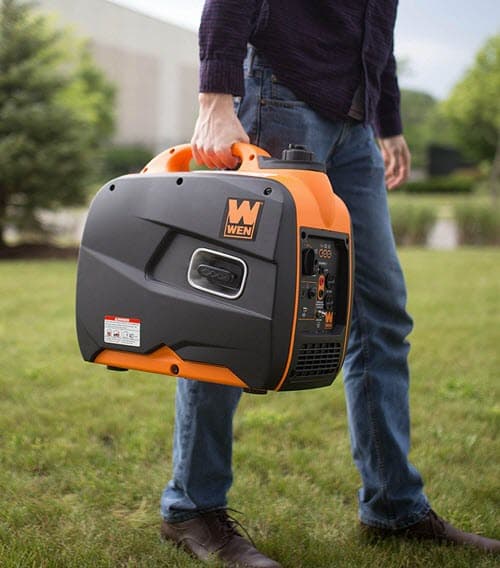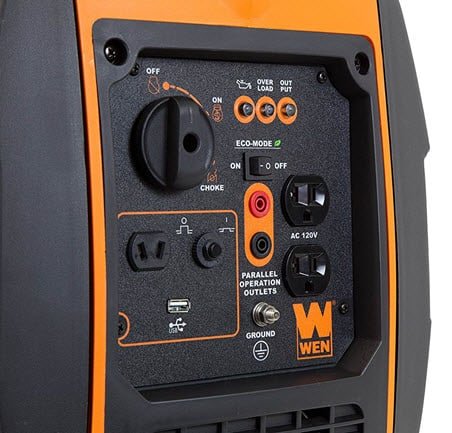How To Keep Tent Cool Camping On The Beach With A Tent AC
You love camping and want to keep cool while camping at the beach. If you wonder how a tent air conditioner would work on the beach, you are at the right place.
Can tent air conditioners work on the beach? Yes, portable AC units work well in tents or campers. You can buy a tent with an AC flap and use a window AC unit. We’ll show you how it can work for you.
This article will go over the options, show you how to size an AC by BTU and discuss how you will power it.
What Are Air Conditioning Options For Keeping Your Tent Cool When Beach Camping?
You have two choices for blowing cold air in your camping tent:
- Window AC unit
- Free-standing portable air conditioner
All air conditioner units will do the job to remove hot air, but you’ll need a generator for camping AC.
This also is required for a camping tent cooling fan you can use to keep fresh air flowing while camping.
What Is A Portable AC Unit?
These are floor units that usually have 4 caster wheels. You can roll it around to the best available location. You will want to choose by a window and close to the electrical port.
These units range from 8,000 BTU to 14,000 BTU. They can weigh up to 64 pounds. There are 115 volt and 12 volt models. The 115 volt models need a lower 6.3 amperage. The 12 volt need a higher amperage.
Learn more about portable AC units: The Best Portable Air Conditioners
Using A Portable Air Conditioner
- Install the exhaust hose to dehumidify and the window venting kit. This will provide fresh ventilation for your tent living area.
- Keep this unit away from the tent doors and main windows to reduce sand intake by the portable AC unit. Make sure to install ventilation kit and setup to filter intaking sand.
What Is A Window Unit Air Conditioner?
This is simply a window unit air conditioner you would buy at Walmart or a hardware store. They range from 5,000 to 28,000 BTUs.
The most a normal camping tent will need between 5,000-7,000 BTU. These can weigh up around 50 pounds and require between 4-7 amps at 115 volts.
The Ozark Trail 16×16-Feet 12-Person 3 Room Instant Cabin Tent is a great example of a roomy tent with an AC port to add your AC window unit.
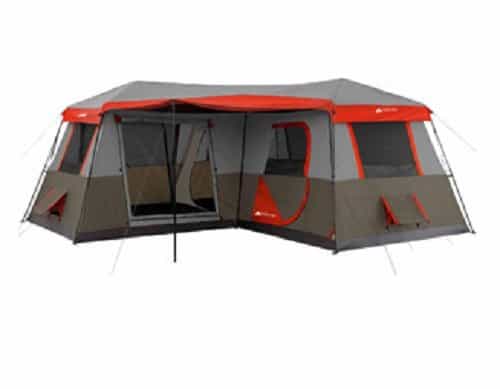
How Do You Install And Use A Window Unit For A Tent?
Installing a window unit AC is easy. You will need the following:
- Place AC unit on a stand or crate for support
- Apply a seal around the unit. I recommend a foam adhesive sealer tape to apply around the window unit, the exhaust hose and ventilation kit to seal open air cracks and seams
- You can use a set of bungee cords to keep the unit fixed under the flap
Cleaning The AC’s Outdoor Unit
Blowing sand is a constant issue on the beach and will provide the wear and tear of dust storms. Since this unit is outside, it requires cleaning of filters and coils after each beach trip. Fasten a fine screen material around the unit. This will help in reducing sand accumulation.
Bud Blankenship’s “Camping with Cats: Tent Air Conditioning Setup and Supper” is does a great job describing how to setup a tent with an air conditioner.
Portable Tent ACs vs Window Unit ACs
You have two choices for cooling your tent or camper with an AC. Here are the pros and cons.
If you choose to go with a window air conditioner though it’s best to go with a smaller sized unit. There are two reasons for this option:
- The first is that you will obviously have to transport and move this AC unit around, so the smaller the better.
- The other reason to get a smaller window AC unit is up to your tent is the best way to make the temperature and humidity inside as comfortable as possible.
Portable Tent Air Conditioners
Pros
cons
Window Unit Air Conditioners
Pros
cons
What Tent Can You Use For A Window AC?
If your tent will use an outside window unit, then try to buy one with an AC port. This is vent flap specifically designed to allow for a window unit air conditioner to blow air into the tent.
Alternatively, you can use the back door flap if you can’t find a tent you like with an AC port. Then use a plastic tarp over the AC unit. This will need more creativity in sealing your tent around the unit.
Choose a tent that allows for sealing the ventilation seams located either along the top or bottom of the tent walls. This is to keep the humidity out of the tent while using the AC unit. Good old duct tape will do the trick if your tent doesn’t seal ventilation seams.
Sam Woodward’s “Ozark trail 3 room 10 x 20 family tent with tent air conditioner” is the video I found that does a great job describing using a tent with an AC port.
Camping Tent With A Built-In AC Port vs DIY An Air Conditioning Port
Using a tent with an AC port has its advantages in certain situations.
Next, If you are going to use a window AC unit on a camping trip, you will need:
- A tent with an AC port that allows you to attach the window AC unit to the side of certain tent models. There are several options for doing this, however, purchasing a camping tent with an air conditioning port is by far the best and simplest method.
- The second alternative is to update their existing tents, which isn’t ideal and may result in your tent’s structural integrity being compromised.
If you’re looking for a new tent and wish to connect an air conditioner, you should definitely think about one with a built-in air conditioning port.
How To Use A Do It Yourself AC Boot
Some camping YouTubers have posted DIY ways to add an air conditioner boot to about any existing tent. These custom solutions are sold as a kit and will require some actual cutting into the tent wall. You would then use an adhesive to secure the provided flange to the tent.
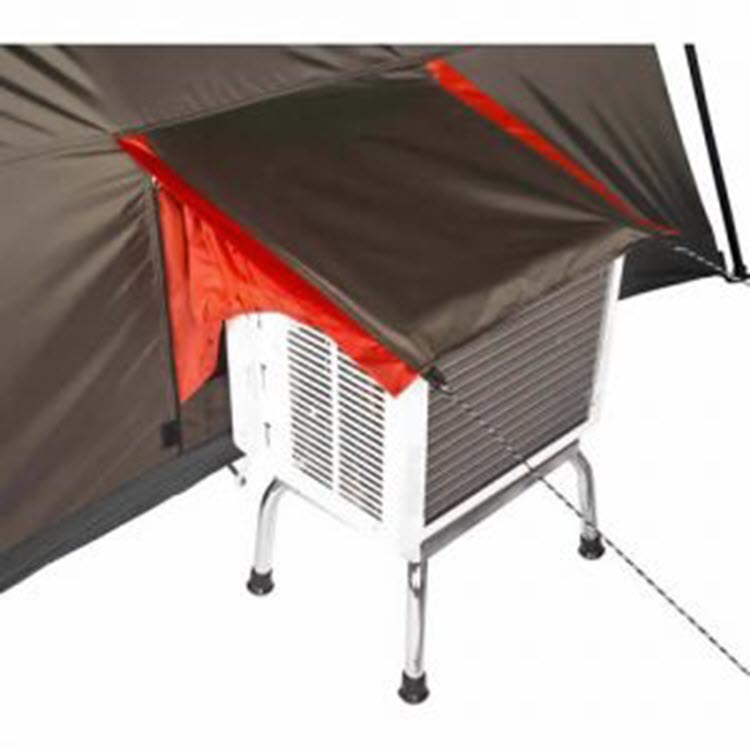
Determining Air Conditioning BTU Requirements by Tent Size
Sizing your air conditioner is a simple process. Square footage is the flat area of your tent. Get the square footage of your tent by multiplying the length in feet by the width in feet. A simple rule of thumb is to reduce the sleeping capacity of the tent by subtracting 2 from the rated capacity, in order to make for more comfortable sleeping.
Use the corresponding BTU (British Thermal Unit) required to size the air conditioner rating needed to cool off your tent. This rating works the same for both window units and portable AC units.
BTU Cooling Capacity Needed By Tent Size
| Tent Size | Square Footage | BTU Capacity Needed |
|---|---|---|
| 150 up to 250 | 50 up to 100 | 4,000 |
| 5 – 7 Person | 100 up to 150 | 5,000 |
| 8 – 9 Person | 150 up to 250 | 6,000 |
| 10 – 12 Person | 250 up to 300 | 7,000 |
| 12 – 15 Person | 300 up to 500 | 9,000 |
How to Power Your Air Conditioner
The average size tent will require a target 7,000 BTU to keep cool. It will take approximately 670 watts to run with a startup load of 2010 watts.
Quick Calculations
To Convert AMPS to WATTS:
Multiply: AMPS X 120 (AC voltage) = WATTS This formula yields a close approximation of the continuous load of the appliance
To Calculate approximate Startup Load:
Multiply: WATTS X 2 = Starting Load This formula yields a close approximation of the starting load of the appliance, though some may require an even greater starting load. NOTE: Induction motors such as air conditioners, refrigerators, freezers and pumps may have a start up surge of 3 to 7 times the continuous rating.
Most often the start up load of the appliance or power tool determines whether an inverter has the capability to power it.
For example, you have an air conditioner with a continuous load of 5.583 amps, and a start up load of 16.75 amps:5.583 amps x 120 volts = 670 watts continuous16.75 amps x 120 volts = 2010 watts starting load
You would need an inverter with peak-surge rating greater than 2010 watts
FORMULA to convert AC Watts to DC Amps:
AC Watts divided by 12 x 1.1 = DC Amps
(this is the size vehicle alternator you would need to keep up with a specific load; for example, to keep up with a continuous draw of 670 watts, you would need a 62 amp DC alternator)
Inverter Generator
A gas powered inverter generator, such as the WEN 56200i Super Quiet 2000-Watt Portable Inverter Generator, will consume around 4 gallons of oil/gas a day to continuously run your AC unit and will cost about $450 to purchase. It has a 1600 running watt output and a 2,000 watt surge output. It is rated to consume 1 gallon of oil/gas every 6 hours at 1/2 capacity.
Weighing at 48 pounds, it’s better to keep around camp. This model has state of the art noise suppression that rates right at 51 decibels which the other campers will love.
Gas Powered Generator
A gas powered generator, such as the DuroMax XP13000HX Dual Fuel Portable Generator-13000 Watt Gas or Propane Powered, does not have an inverter or the new sound proofing technology. So, it rates at a higher 65 decibels and at a weight of 53 pounds. At 1300 running watts and 2000 surge load, it is a bargain.
An inverter generator is recommended because of the clean power, that is, the lower harmonic distortion that that may harm electronics and your precious air conditioner.
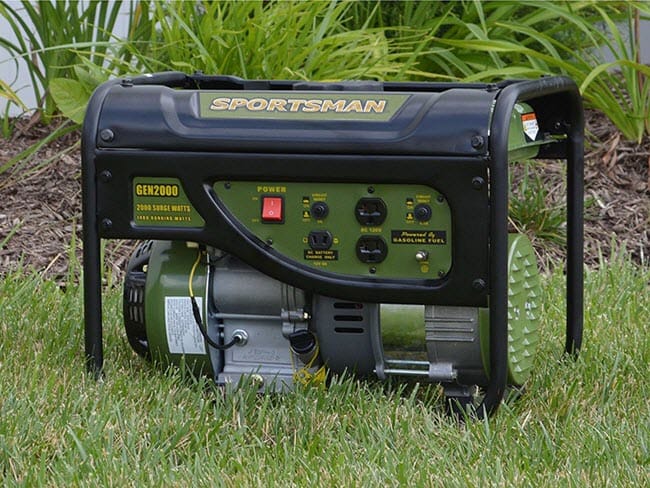
Keeping Your Tent Cool
The beach is a high humidity environment that will cause a higher heat index, especially when the wind is not blowing. This is the biggest difference between camping on the beach and camping inland.
Maintaining a cooler tent temperature will require a few practices:
- Because of the weight requirements, plan on a beach camp to setup your tent, air conditioner and generator.
- Maintain a tight seal for the window unit insulation. This will keep out the humidity.
- Keep the tent air ventilation flaps zippered and fastened.
- Keep the door traffic to a minimum. The tent will lose its cool air quickly and take time to build up again.
- Run the air conditioner at a higher temperature but still comfortable. This will allow the temperature range to be smaller.
A carbon monoxide detector is recommended to protect against fumes anytime you add an AC or heater in an enclosed area like your tent.
Maintaining Your AC for Long Life
Clean your window air conditioner unit after each beach visit by:
- Wash the filter with soapy water
- Remove the front cover and spray the unit coils and fan wheel with water.
- Use a soft bristle brush to clean the dirt and sand from vents and wash with a water hose.
- Use the water hose to softly spray the coils and tilt to drain sand and dirt from the unit
- Let completely dry and reassemble
Clean the filter of the portable air conditioner after each beach visit is adequate to maintain this unit.
Related Questions:
Are dome tents a good candidate for using an air conditioner? The shape does not provide a flat surface wall to attach a window unit. A portable AC unit could work if place in the center for larger diameter tents.
Can you run an air conditioner run off of your car battery? Yes, but it would need to keep running. The typical car alternator can output around 200 Amps at 14.5 volts. A 2000 watt AC unit will require DC 62 amps (520 watts) from a power inverter and will last approximately 2 hours with the car off.


